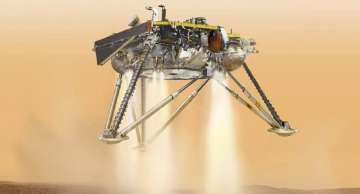NASA's InSight lander which touched down on the Martian equator in November 2018, has revealed secrets about the Red Planet's weather patterns, including details about its surface tornadoes, and the steady, rumble of low-frequency sounds on the planet, a new study says. The research, published in the journal Nature Geoscience, noted that Mars experiences strong daily pressure and temperature fluctuations, stronger than on the Earth.
"The atmosphere is so thin that it can heat up and cool down much faster than on Earth. This is entirely new territory we are exploring," said Don Banfield, lead author of the study from Cornell University in the US.
The researchers noted that about a month after landing, InSight endured a large dust storm -- a periodic global event on Mars which, they said, could dramatically change the Red Planet's weather and climate.
The scientists noted daily changing winds controlled by the seasonal freezing and thawing of the carbon dioxide in the Martian polar caps.
InSight's onboard equipments included a seismometer for detecting Mars' quakes, sensors for gauging wind and air pressure, a magnetometer for measuring the planet's magnetic forces, and a probe designed to take the planet's temperature, the American space agency had said in a statement.
Banfield and his team assessed measurements taken by InSight and detected atmospheric gravity waves, which are oscillations of air molecules similar to how water wavelets form when a pebble is dropped in a puddle.
They said such gravity waves on the Earth can create linear rows of rolled "morning glory" clouds -- white, puffy clouds that look like lofty jelly rolls.
"We're still working to understand what these waves can teach us about Mars," Banfield said.
The scientists also observed "infrasound" on the Martian atmosphere, which are pressure oscillations below the frequency of 10 Hertz (Hz).
They said these are low rumbling oscillations below what the human ear can detect.
"We expected infrasound would exist, but this is the first direct measurement," Banfield said.
"It's still mysterious as to exactly what causes the signals we've heard, but we'll keep studying," he said.
The research team also found vortices, known as "dust devils", which are small whirlwinds forming into tiny tornadoes, caused by wind shear and convection near the surface.
Banfield speculated that these could be the cause of Mars' constant dustiness.
"We have seen the pressure signature of thousands of dust devils, and we have tried to take images at the right times of the day. We've caught absolutely no dust devils on camera," Banfield said.
"Other landers have more effortlessly imaged dust devils, so it's surprising that we haven't even captured an image of one," he added.
Also Read | Exposure to alcohol advertising linked to teen drinking: Study
Also Read | 25% climate change messages on Twitter written by bots: Study
